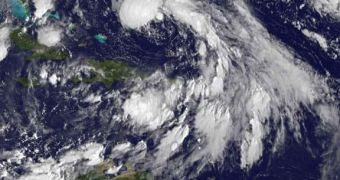New satellite images have revealed that the 2010 hurricane season is for from over for America. Subtropical storm Otto has been lurking east of the Caribbean since yesterday, October 6.
The subtropical depression that “haunted” the area for a few days finally decided to develop into a subtropical storm, and was therefore given an official name, Otto.
It is only the 15th named storm that developed in the Atlantic Ocean since the season was declared open, back in June. Meteorologists say that it will be over by next month.
According to conventions, only tropical storms and hurricanes get names. Otto is very different from tropical storms that came before it for several reasons.
First of all, it has broad wind patterns, and secondly, maximum sustained wind intensity areas are located a lot farther from the center of the system than they are in tropical cyclones.
At this point, the storm boasts maximum sustained winds of 60 miles per hour (95 kilometers per hour). However, it does have great potential for strengthening in the coming days.
The next 48 hours are especially critical, say experts from the National Hurricane Center (NHC), quoted by Our Amazing Planet.
The Center now forecasts that the weather event will not pass close by to the eastern coast of the United States, and that it will not make landfall anywhere on dry land.
But the subtropical storm could develop into a fully-fledged tropical storm by tonight, or Friday morning, meteorologists believe. The Leeward islands, Virgin Islands and Puerto Rico may be affected by rains produced by Otto.
This year was very rich in hurricanes and storms, with 17 named atmospheric events. Generally, the average is 11 tropical storms with six of them becoming hurricanes per season.
But this gave experts with NASA and other research initiatives the possibility to conduct research in the Gulf of Mexico using specialized airplanes.
The goal of the studies was to determine the factors that trigger the formation of dangerous hurricanes from average tropical storms.
Some of the atmospheric events simply fizzle out into heavy rain showers, whereas others go on to form tornadoes, and cause massive devastation.

 14 DAY TRIAL //
14 DAY TRIAL //